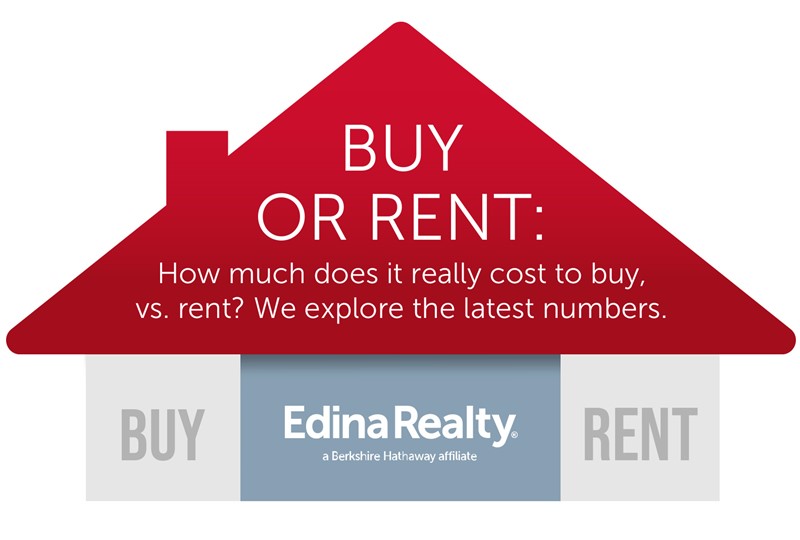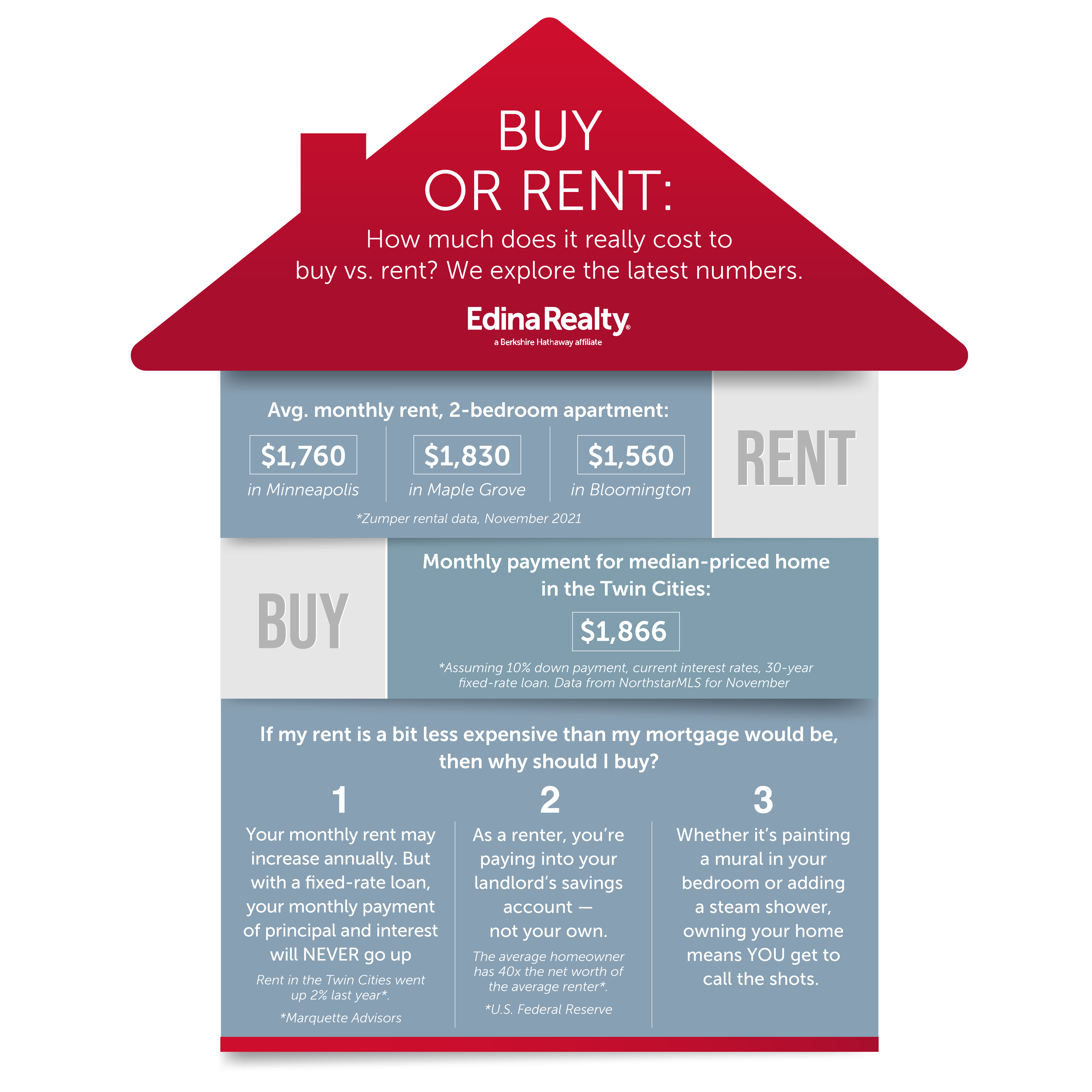
We’ve talked a lot about record-setting price growth for homes over the past year, but there’s another segment of the market that is making history, too: The rental market. In 2021, a record number of renters leased apartments in the Twin Cities metro area. But unlike the double-digit increases we’ve seen in housing prices, rental prices rose just 2.1% last year.
This brings up a question that we hear all the time: How can I truly determine if it’s time for me to buy? How do I know I’m not in a better position as a renter? Below, we provide ways for you to calculate the short- and long-term costs and benefits of renting or buying a home in Minnesota or western Wisconsin.
Remember, though, the below insights are based on generalized market stats, not your unique financial situation. The best way to assess your potential for homeownership is to speak with a home mortgage consultant.

Monthly payments
When talking about renting versus buying, it makes sense that the first comparison should be the average monthly expense of renters and homebuyers. According to Zumper, in December 2021, the median rent of a two-bedroom apartment was:
- $1,760 in Minneapolis
- $1,830 in Maple Grove
- $1,560 in Bloomington
Now let’s look at what it would cost to buy a median-priced home in the metro area, which in November 2021 was priced at $340,000. Assuming a homebuyer had a 10 percent down payment and good credit that would allow them to secure a 3.5 percent interest rate on a 30-year fixed rate mortgage, the homebuyer could pay around $1,866 per month for “PITI,” which encompasses:
- Principal:The monthly payment you make that reduces your outstanding mortgage balance
- Interest: The monthly payment you make that goes to the lender in exchange for the loan
- Taxes: The annual property tax rate for your home, divided into monthly payments
- Insurance: The payments you make toward homeowners’ insurance and any private mortgage insurance
In this example, the cost of owning a home would be a few hundred dollars more if buying in a suburb like Bloomington, and within $150 if purchasing in Minneapolis or Maple Grove. Of course, if the homebuyer had a larger down payment or purchased a home for less than the median price for our area, their overall costs would go down.
To calculate your anticipated mortgage cost, use the Edina Realty Payment Calculator.
Net worth
When monthly expenses are essentially a wash, it can be easy to put off buying a home, but when you look at the effects over the long-term, buying comes out ahead by a long shot. A person’s home is usually their biggest investment and their greatest asset.
According to the Federal Reserve’s Survey of Consumer Finances, which was last conducted in 2019, the net worth of typical homeowners is 40 times that of the net worth of the typical renter. Specifically, the average homeowner in 2016 had a net worth of over $255,000 while the average renter’s net worth was just $6,300.
How does this happen? When you pay rent, you are contributing to your landlord’s mortgage (or if they own the property outright, it goes directly into their pocket). Meanwhile, as a homeowner, you are essentially paying into a long-term savings account that you can cash out when you sell your home — or much earlier, if you need extra money on hand.
Payment increases
Another benefit of being a homeowner is that your monthly mortgage payment of principal and interest will not increase if you secure a fixed-rate mortgage. Meanwhile, renters are at the mercy of their landlords, who can typically raise the rent annually based on demand in the market.
In the Twin Cities area, median rent increased 2.1% in 2021, which seems meager when you consider just one year. Over time, though, these increases add up. The monthly principal and interest payment on a fixed rate mortgage, on the other hand, won’t increase — even in years when property values increase by 16% or more.
100 percent freedom
Of course, not every pro and con can be weighed in objective terms. If you’ve ever looked around a rental and wished you could rip up the dingy carpet or put in a new light fixture, you should know that homeownership comes with the freedom to decorate and renovate to your heart’s content.
In the era of HGTV fixer upper shows and DIY tutorials going viral on TikTok and Instagram, you may feel that you are ready to take on a larger home bucket list — from painting doors, to scraping off popcorn ceilings, to updating a bathroom with a fun wallpaper.
Additional considerations
Of course, many buyers are not waiting to purchase simply because they can’t decide between renting and buying. There are significant costs associated with purchasing a home, the largest of which is the down payment. Many of today’s would-be buyers can technically afford the cost of a mortgage, but they are unable to meaningfully save enough for a down payment on a house.
These buyers can look into down payment assistance programs, and they should also speak with a home mortgage consultant to see if they qualify for any mortgage programs for buyers with minimal savings. FHA loans, for example, are known as “helper loans'' because they assist buyers who may not have perfect credit or a 20% down payment. In fact, for the right candidate, FHA loans can be approved with as little as 3.5% down.
Last, the cost of a down payment isn’t the only financial consideration that homebuyers must keep in mind. They should also do their best to budget the cost of items that they never had to worry about when renting. From home maintenance, to furnace tune-ups, to utility costs and even lawn care equipment, these costs can add up fast.
Getting started
If you ran the numbers and you’re ready to enter the home buying market, contact Edina Realty or your agent today. We offer insights and guidance to homebuyers across Minnesota and western Wisconsin every day, and we’d love to start helping you.









 ©2025 Prosperity Home Mortgage LLC®. (877) 275-1762. 3060 Williams Drive, Suite 600, Fairfax, VA 22031. All first mortgage products are provided by Prosperity Home Mortgage, LLC®. Not all mortgage products may be available in all areas. Not all borrowers will qualify. NMLS ID #75164 (For licensing information go to: NMLS Consumer Access at
©2025 Prosperity Home Mortgage LLC®. (877) 275-1762. 3060 Williams Drive, Suite 600, Fairfax, VA 22031. All first mortgage products are provided by Prosperity Home Mortgage, LLC®. Not all mortgage products may be available in all areas. Not all borrowers will qualify. NMLS ID #75164 (For licensing information go to: NMLS Consumer Access at